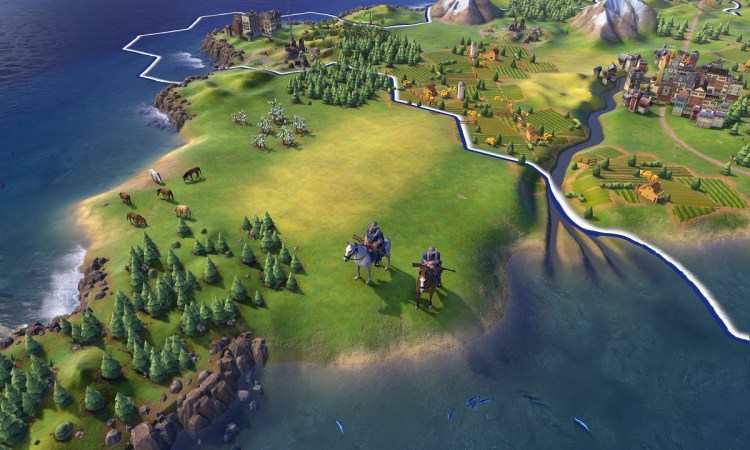The A.I. seems smarter

Above: Teddy Roosevelt is one of the leaders in Civilization VI.
The experience of dealing with the barbarians made an impression on me. The artificial intelligence of the computer-controlled players are improved from the previous game.
And that is visible in more ways than one. This time, the non-player A.I. will always have some kind of agenda that drives their behavior. You can’t really change someone’s agenda, such as Manifest Destiny. But you can change their attitude toward you quickly if you invade them.
This means that diplomacy could be dynamic, changing as the ages evolve and as the leaders show their character.
“We have a system that has a historical agenda linked to a leader, but they also have random leaders, chosen game by game, that are hidden from the player,” said Andrew Garrett, an A.I. expert on the Civilization VI team.
When I expanded into new regions, I ran into the Americans, headed by Teddy Roosevelt. He talks softly and carries a big stick. That means that he will be wary of anyone amassing military troops on his borders, and he will do his utmost to defend his territory aggressively. That kind of agenda was clear to see.
You can find out what the agenda of a particular leader is by spying or just understanding their behavior. If a leader is obsessed with Wonders, he or she will strive to out-build the other societies when it comes to creating wonders. If you challenge that leader in the Wonder race, you’ll likely come into conflict. You may even be able to set leaders against each other through careful observation. Civilization VI will have a new espionage system, but Firaxis isn’t describing it yet.
I didn’t face off against Roosevelt for long. After his initial alarm at my armies drawing near, he made a peace treaty with me, and we coexisted on that border.
The art style matches the map changes

Above: Civilization VI has a “color language” for distinguishing buildings and terrain.
The visual style is distinct from past games. I loved the way that Civilization V looked, with its shift toward greater realism. It really made me feel immersed in another world. I also like the art in this game, but in a completely different way.
Things are spread out more on the map. Every building in the game is modeled. You’ll see birds flying around the buildings. You’ll be able to zoom in and see the fruits of your labor now. The world is more vivid and alive. The leaders will be more expressive and realistic, all with the aim of making you believe the world is real.
This new art style is geared toward enabling you to zoom all the way on your units and districts. I enjoyed going in close and then pulling back to get a better perspective.
I did recognize one flaw in the graphics. If you explore an area, it can go a little dark on you once your units leave that area. When it goes darker, you can still see some of the general outlines like mountains. The map goes from colorful to a drab brown in these areas. But the borders of the darkened region look like jagged coastlines. In the watery region that I was exploring, this effect fooled me. I thought that there were jagged coastlines in parts of the map — which I had already previously explored — when in fact this was really just open ocean. I think Firaxis needs to fix this flaw.
Conclusion

Above: Civilization VI debuts on October 21, 2016.
So far, I have barely scratched the surface on Civilization VI. And the flaws are the tiniest of flaws. I’m looking forward to seeing a lot more of this game, and I can see that Firaxis has put a lot of thought into the way the game plays. There are crucial tests yet to come, like how fast the game runs on modern computers. But most of it looks good so far.
VentureBeat's mission is to be a digital town square for technical decision-makers to gain knowledge about transformative enterprise technology and transact. Learn More

